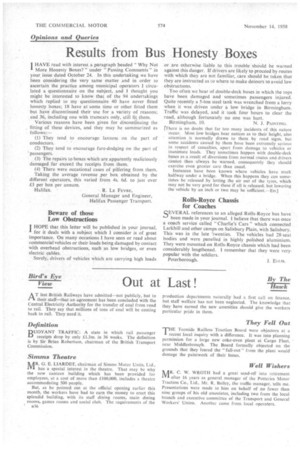Results from Bus Honesty Boxes
Page 70

If you've noticed an error in this article please click here to report it so we can fix it.
I HAVE read with interest a paragraph beaded "Why Not More Honesty Boxes?" under "Passing Comments" in your issue dated October 24. In this undertaking we have been considering the very same matter and in order to ascertain the practice among municipal operators I circulated a questionnaire on the subject, and I thought you might be interested to know that of the 94 undertakings which replied to my questionnaire 40 have never fitted honesty boxes; 18 have at some time or other fitted them but have discontinued their use for a variety of reasons; and 36, including one with tramcars only, still fit them.
Various reasons have been given for discontinuing the fitting of these devices, and they may be summarized as follows:—
(1) They tend to encourage laxness on the part of conductors.
(2) They tend to encourage fare-dodging on the part of passengers.
(3) The repairs to boxes which are apparently maliciously damaged far exceed the receipts from them.
(4) There were occasional cases of pilfering from them.
Taking the average revenue per box obtained by the different operators, this varied from 4s. 6d. to just over £3 per box per annum.
Halifax. R. LE FEVRE,
General Manager and Engineer, Halifax Passenger Transport.
Beware of those Low Obstructions
I HOPE that this letter will be published in your journal, 1 for it deals with a subject which I consider is of great importance. On many occasions I have seen or read about commercial vehicles or their loads being damaged by contact with overhead obstructions, such as low bridges, or even electric cables.
Surely, drivers of vehicles which are carrying high loads or are otherwise liable to this trouble should be warned against this danger. If drivers are likely to proceed by routes with which they are not familiar, care should be taken that they are instructed as to where to make detours to avoid low obstructions.
Too often we hear of double-deck buses in which the tops have been damaged and sometimes passengers injured. Quite recently a 5-ton steel tank was wrenched from a lorry when it was driven under a low bridge in Birmingham. Traffic was delayed, and it took four hours to clear the road, although fortunately no one was hurt.
Birmingham, 10. N. J. PAINTING.
(There is no doubt that far too many incidents of this nature occur. Most low bridges bear notices as to their height, also attention is normally drawn to them by road signs, but some accidents caused by them have been extremely serious in respect of casualties, apart from damage to vehicles or inanimate loads. They sometimes happen with double-deck buses as a result of diversions from normal routes and drivers cannot then always be warned, consequently they should exercise even greater care than usual.
Instances have been known where vehicles have stuck halfway under a bridge. When this happens they can sometimes be released by letting the air out of the tyres, which may not be very good for these if all is released, but lowering the vehicle by an inch or two may be sufficient—En"
Rolls-Royce Chassis for Coaches
SEVERAL references to an alleged Rolls-Royce bus have
been made in your journal. I believe that there was once a coach service called "Charlie's Cars" which connected Larkhill and other camps on Salisbury Plain, with Salisbury. This was in the late 'twenties. The vehicles had 28-seat bodies and were panelled in highly polished aluminium. They were mounted on Rolls-Royce chassis which had been considerably lengthened. I remember that they were verypopular with the soldiers.
Peterborough. J. Ems.




















































































































